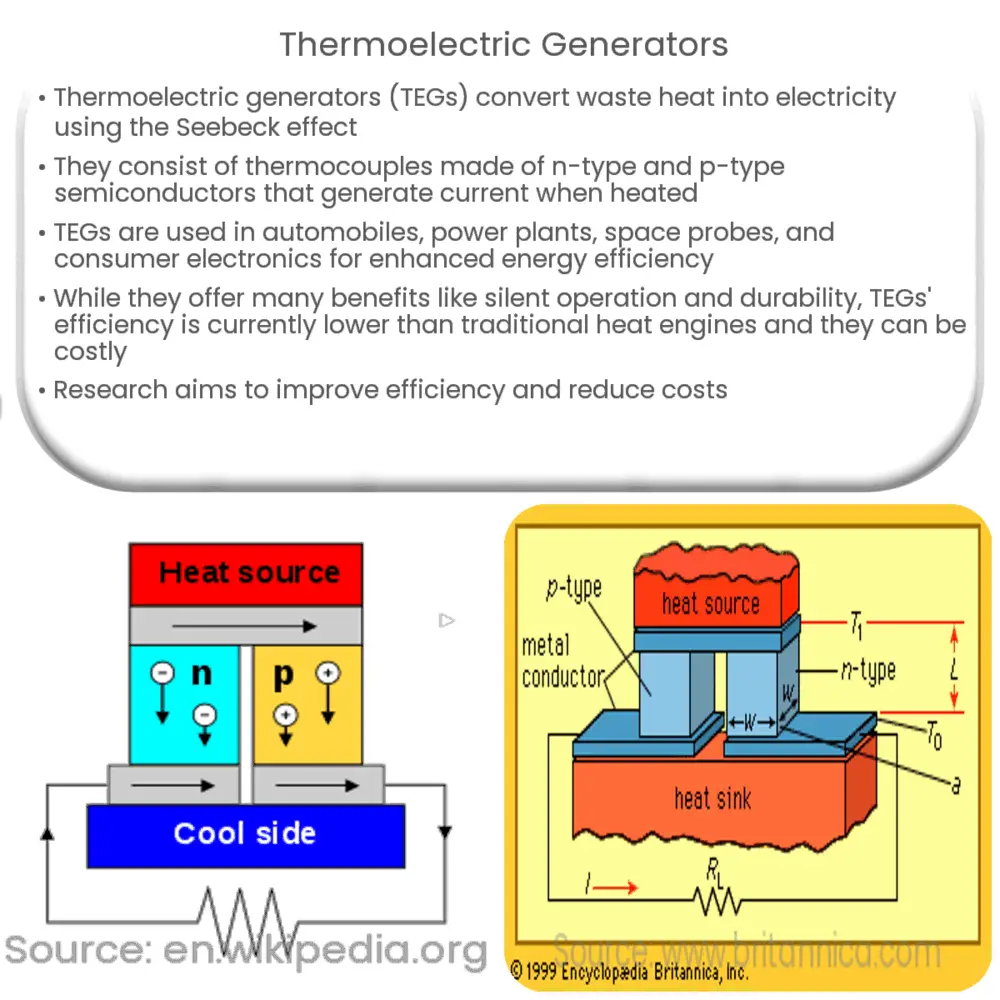Explore the workings of Thermoelectric Generators (TEGs), their applications in various sectors, benefits, limitations, and future prospects.

Introduction to Thermoelectric Generators
Thermoelectric generators (TEGs) are fascinating devices that serve as an efficient bridge between thermal and electrical energy. Leveraging the principles of the Seebeck effect, they offer the ability to convert waste heat into valuable electricity.
The Working Principle
The underlying mechanism that powers thermoelectric generators is the Seebeck effect. Discovered in 1821 by German physicist Thomas Seebeck, it’s a phenomenon where a temperature difference between two dissimilar conductors or semiconductors (thermoelectric materials) generates a voltage difference.
- The Seebeck effect: This effect sets the foundation for TEGs. When two dissimilar materials are connected and subjected to different temperatures, an electric current is induced to flow.
- Thermoelectric Materials: The efficiency of a TEG primarily depends on the thermoelectric materials used. These materials are semiconductors, often made of bismuth telluride (Bi2Te3), with distinct properties that allow efficient conversion of heat to electricity.
Construction of Thermoelectric Generators
TEGs are built with several thermocouples arranged in series or parallel, depending on the required voltage and current. A thermocouple consists of two thermoelectric materials (n-type and p-type semiconductors) connected electrically in series and thermally in parallel.
- N-type Semiconductor: This type of semiconductor has an abundance of free electrons. When heated, these electrons move from the hot side to the cold side, generating an electric current.
- P-type Semiconductor: These semiconductors have “holes”, or the absence of electrons, as charge carriers. When heat is applied, the holes move from the hot side to the cold side, in the opposite direction of the electrons in the n-type semiconductor. This movement again results in an electric current.
Applications of Thermoelectric Generators
TEGs have numerous applications across various sectors, primarily where waste heat is generated. These generators convert that heat into usable power, leading to enhanced energy efficiency. From power plants to automobiles, and even space probes, the potential application of TEGs is vast and continues to grow.
Deep-Dive into Applications
- Automotive Industry: TEGs are utilized in automobiles for waste heat recovery. The heat produced by an engine, typically wasted, can be converted into electricity and used to power vehicle electronics, thus improving overall vehicle efficiency.
- Power Plants: Power plants, which generate significant amounts of heat, can utilize TEGs to transform this waste heat into supplemental electricity, enhancing plant efficiency and reducing environmental impact.
- Space Probes: Radioisotope Thermoelectric Generators (RTGs) are a type of TEG used in space probes like the Voyager spacecraft and the Mars rover. These devices convert heat from decaying radioisotopes into electricity, providing reliable, long-term power in environments where solar power is not feasible.
- Consumer Electronics: On a smaller scale, TEGs can be found in devices like self-powered watches and camping equipment, which convert body heat or fire heat into electricity.
Benefits and Limitations of Thermoelectric Generators
TEGs come with a suite of benefits. They are solid-state devices, which means they have no moving parts, leading to less maintenance and longer lifespans. They can operate in a wide range of temperatures and their silent operation makes them suitable for noise-sensitive applications. However, TEGs are not without limitations. Their efficiency is generally lower than traditional heat engines and the high cost of thermoelectric materials can also be a deterrent to widespread adoption.
Future of Thermoelectric Generators
The future of TEGs is promising. Research is ongoing to find more efficient and cost-effective thermoelectric materials. Innovative nanostructuring techniques are being explored to reduce thermal conductivity and increase conversion efficiency. There is also potential for TEGs in the growing field of Internet of Things (IoT) devices, where they can provide self-sustaining power by harvesting heat from the surroundings.

